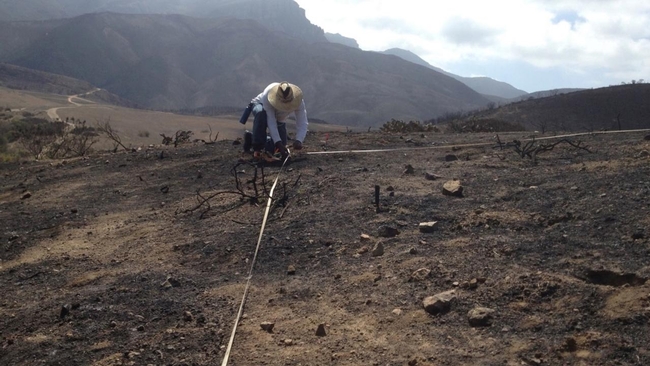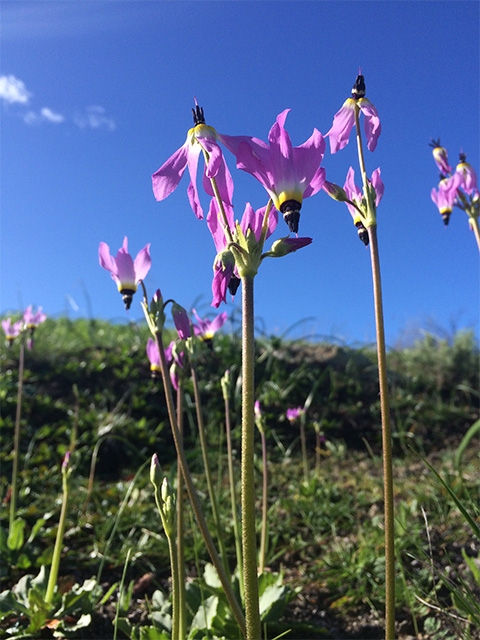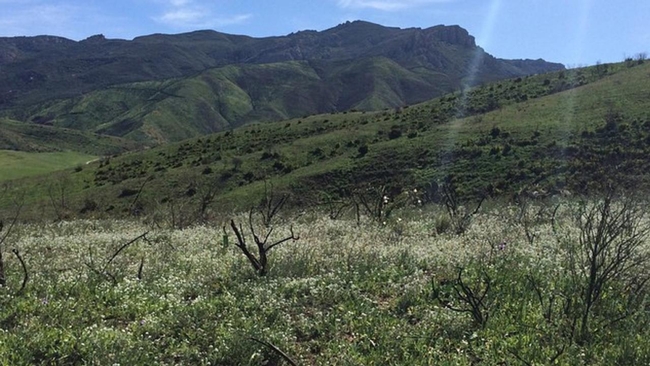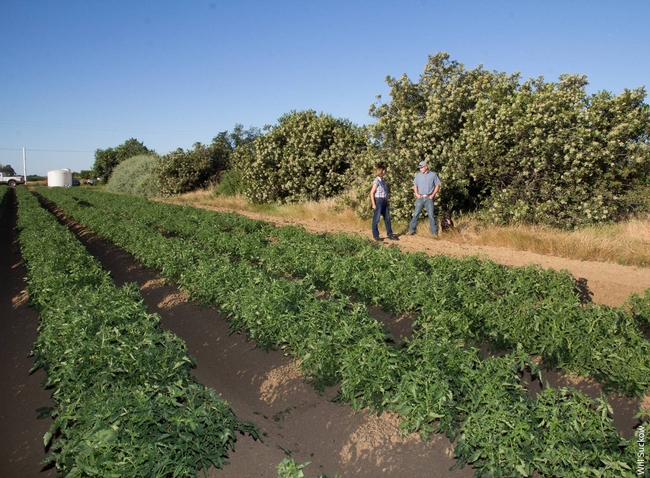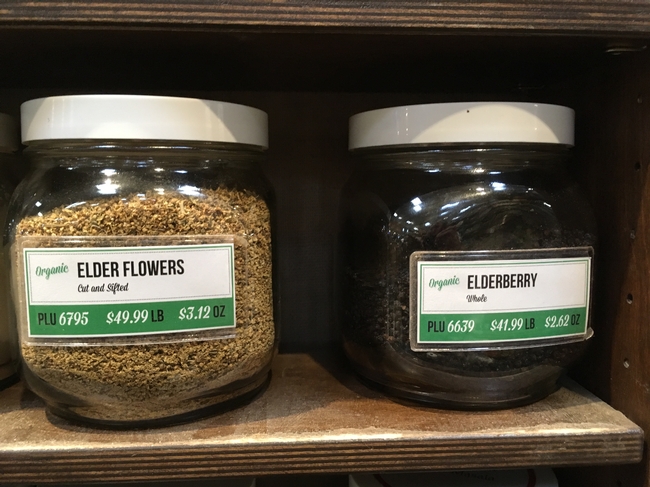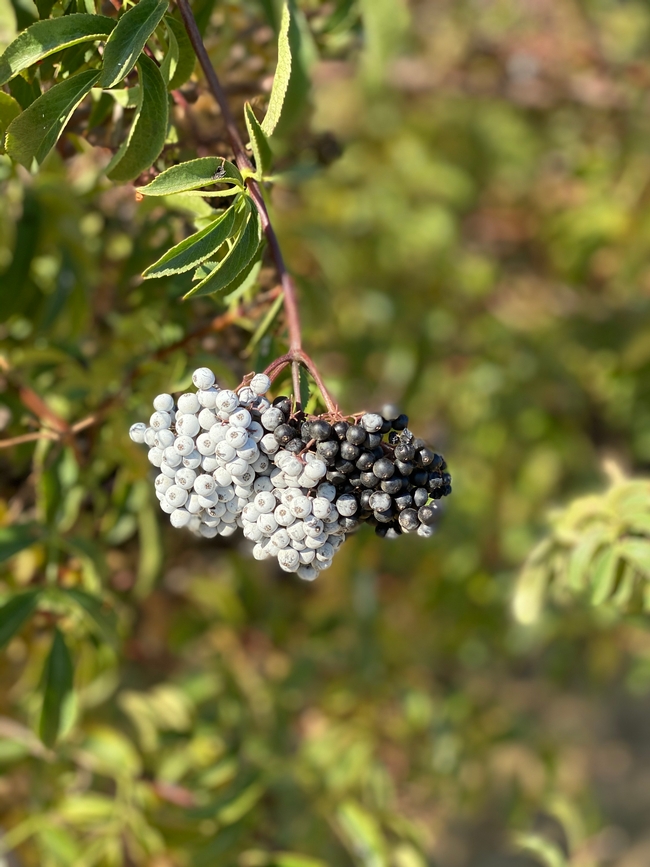
Posts Tagged: Native Plants
Car fumes, weeds pose double-whammy for fire-loving native plants
Wildflower displays threatened
Northwest of Los Angeles, springtime brings native wildflowers to bloom in the Santa Monica Mountains. These beauties provide food for insects, maintain healthy soil and filter water seeping into the ground – in addition to offering breathtaking displays of color.
They're also good at surviving after wildfire, having adapted to it through millennia. But new research shows wildflowers that usually would burst back after a blaze and a good rain are losing out to the long-standing, double threat of city smog and nonnative weeds.
A recent study led by Justin Valliere, assistant professor in the UC Davis Department of Plant Sciences, found that native wildflowers and other plants that typically flourish following a fire were, instead, replaced by invasive plants on land that received the kind of nitrogen contained in vehicle emissions.
“Many native plants in fire-prone areas rely on fire, and some are entirely dependent on it. Some are even most abundant after a fire,” said Valliere, a UC Cooperative Extension specialist in invasive weed and restoration ecology. “But we found that these fire-following species may be especially vulnerable to the combination of nitrogen pollution and invasive plants.”
That's part of the reason why native plants in these mountains have been declining.
Seeds – banked in the soil and waiting to sprout
The problem faced by native plants can be compared to a drawn-down bank account: Funds withdrawn are not being replaced.
It starts with fire, an important ecological process, Valliere said. Flames burn through plants on the surface and return their nutrients to the soil. Seeds sleeping in the ground wait for the next rain to sprout, then use those nutrients to grow.
“Plant diversity is often highest in growing seasons immediately after a site burns,” he said.
But invading plants have many advantages over native ones. They often sprout earlier, grow faster and create more seeds, all while tolerating drought.
“They're like cheaters,” Valliere said. “They don't follow the same rules.”
Nitrogen, too, is an important piece of every plant's nutrition. They all get a fertilizing boost from nitrogen that floats up in vehicle emissions and falls to the ground. But the invaders use nitrogen and other nutrients to grow faster, winning the race for water and sunlight. As a result, fewer native plants reach maturity, producing fewer seeds that keep their populations thriving.
When the bank balance reaches zero
The 2013 Springs Fire gave Valliere a unique opportunity to study the combined impacts of wildfire and extra nitrogen. He and colleagues from UC Riverside and the National Park Service created test plots in the Santa Monica Mountains where the fire had burned. Then, they added nitrogen to the soil to mimic the amount and type that LA's smog would deposit. Over the study's three years, native plants that typically would have flourished after wildfire instead declined even faster in the plots with added nitrogen.
Native seeds sprouted, but didn't flower. Over time, the soil's bank of seeds drew down.
“Each seed has one chance to flower and reproduce,” Valliere said. “If a seed grows and gets outcompeted, that seed has lost its chance to replenish the seed bank.”
Without the chance to replenish their bank account, native plants will die out, and the whole ecosystem will be thrown out of balance.
“There is inherent value in biodiversity,” Valliere said. “These invasive weeds could prevent the re-establishment of native shrubs after fire, sometimes forever altering the plant community.”
The loss of native plants can have cascading effects on the larger environment, he added. Problems can include the loss of native bees that feed on the flowers, and mudslides when rain makes hillsides unstable.
This problem is likely to repeat in similar areas where biodiversity is highest after wildfires – including parts of the Mediterranean basin, southern Africa and Australia. The addition of city smog “could have serious consequences for the biodiversity of fire-prone ecosystems worldwide,” Valliere warned.
Read the paper, “Nitrogen deposition suppresses ephemeral post-fire plant diversity,” by Justin Valliere, Irina Irvine and Edith Allen.
This article was first published on the UC Davis Department of Plant Sciences website.
Citizen Scientists Invited to Join the Seed Pile Project
Want to join the 2022-23 Seed Pile Project, a community science initiative by Miridae Living Labs of West Sacramento and UC Davis faculty that aims to better understand the dynamics of native plant seed dispersal in human-dominated landscapes? If you live in the Sacramento area (including...
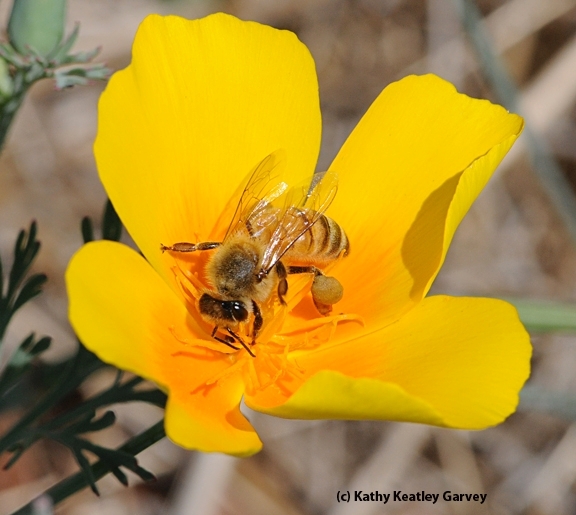
A honey bee foraging on a California golden poppy, the state flower. (Photo by Kathy Keatley Garvey)
Tropical Milkweed Doesn't Deserve the Bad Rap
Fact: Milkweed is the host plant of the monarch butterfly, Danaus plexippus. Fact: Without milkweed, no monarchs. Yet a milkweed species that's been thriving in California for more than a century is getting a bad rap. The California Department of Food and Agriculture (CDFA), apparently...
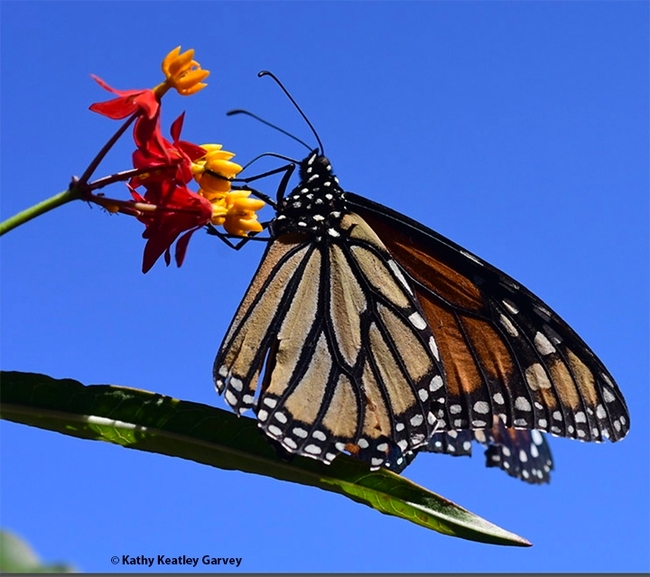
A monarch nectaring on tropical milkweed, Asclepias curassavica.(Photo by Kathy Keatley Garvey)
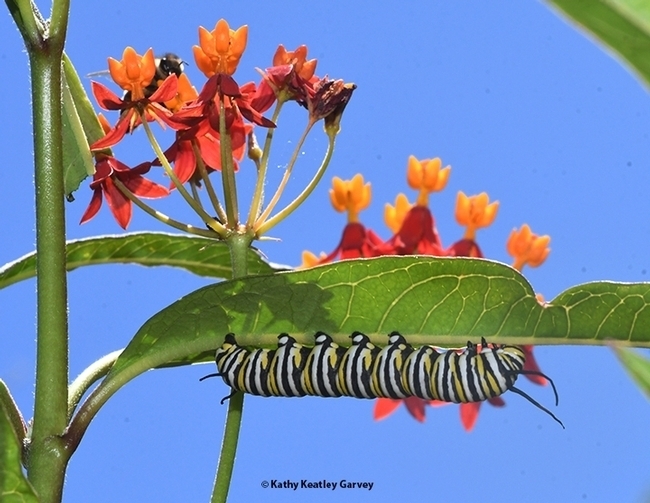
A monarch caterpillar foraging on tropical milkweed, Asclepias curassavica. (Photo by Kathy Keatley Garvey)
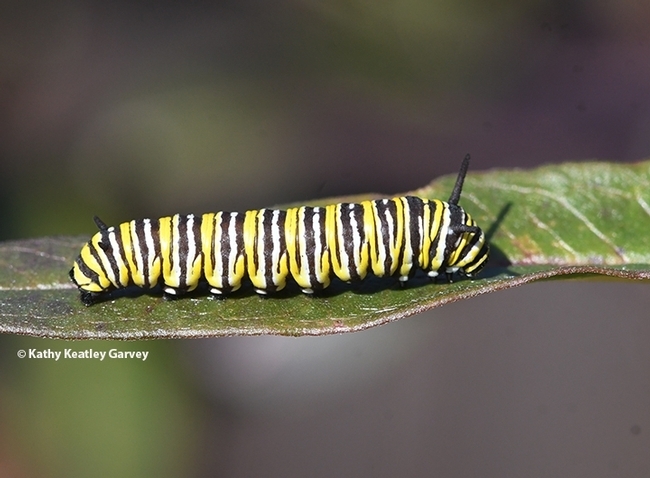
Close-up of a monarch caterpillar. (Photo by Kathy Keatley Garvey)

A monarch laying an egg on a tropical milkweed. (Photo by Kathy Keatley Garvey)
End of Summer Plants for Bees
As we move into the hottest, driest part of the summer, many of our gardens are looking a bit worn out. It's certainly easier to stay inside where it's cool and put garden tasks off until the fall. But the bees are still out there doing their work to bring us food and create habitat for wildlife....
Growing elderberries in hedgerows adds to farm income, benefits environment
As the sustainability of agriculture continues to be threatened by changes in climate, pests and loss of biodiversity, the ancient practice of planting hedgerows with edible and medicinal species such as elderberry can help growers generate additional revenue while fostering beneficial insects and improving soil health.
Most modern-day farmland is occupied by simple “monocrop” systems that often require frequent, energy-intensive inputs like synthetic fertilizers and pesticides to sustain their yields. These practices can be harmful to water quality, biodiversity and soil health.
But farmers who incorporate perennials into their farm landscapes can better harness living things—crop plants, pollinators, beneficial microbes and natural enemies of pests—to provide services rather than adding synthetic products, to the ultimate benefit of the farm and the environment.
Restoring field edges by planting hedgerows is a common way to add perennials to farm fields without taking land out of production. These managed rows of trees, shrubs, grasses and wildflowers were an ancient feature of agricultural landscapes throughout the world.
As farmland industrialized in Europe and North America in the 1900s, many old hedgerows were removed. But hedgerows have seen a resurgence in recent years as their significant environmental benefits—including natural pest control and pollination services, improved soil health and carbon sequestration—are increasingly recognized.
With hedgerows, “the whole farm can be a site of both conservation and profitability,” says Sonja Brodt, deputy director of the University of California Sustainable Agriculture Research & Education Program (UC SAREP).
Hedgerows can be costly to establish, and this is often the reason farmers choose not to use them. But incorporating a harvestable crop into a hedgerow can be profitable.
Brodt is leading a collaborative effort with California farmers and UC researchers to develop native western elderberry as a hedgerow cash crop. Blue elderberry (Sambucus nigra ssp. cerulea) is a native subspecies of elderberry that is well-adapted to Mediterranean climates and grows prolifically across California. It is thought to be more heat- and drought-tolerant than the more commercialized North American and European subspecies of elderberry.
“Elderberries have this great potential as a ‘win-win' crop. Farmers harvesting and selling elderberries from their hedgerows can receive a direct income from a farm practice that benefits the local ecosystem,” says Brodt.
Consumer demand for elderberry-based products has skyrocketed in recent years. Blue elderberry has similar antioxidant levels to blueberries and can be processed into products such as jams, syrups, tea mixtures and herbal supplements.
“We found that two-thirds of surveyed herbal and specialty foods processors and retailers were strongly interested in sourcing California-grown elderberries and couldn't find enough supply to meet their needs” says Gwenaël Engelskirchen of UC SAREP. Farmers who grow blue elderberry can tap into this growing market.
The research team recently completed a field trial in the southern Sacramento Valley to assess the profitability of blue elderberry. They found that elderberry yields from a 1,000-foot, multispecies hedgerow could provide $2,700 to $4,800 in revenue, after harvest and de-stemming costs, in only the second year after hedgerow planting. This revenue helps offset typical hedgerow establishment costs of $3,000 to $4,000, and elderberry revenue is expected to grow over time as the plant yields continue to increase. Value-added processing and specialty products made on-farm could also increase overall profitability.
While native elderberry hedgerows is a new area of research for the University of California, North America's indigenous people have been harvesting and tending blue elderberry in California for hundreds of years. Many Native persons across the state continue to gather, cultivate and use elderberry.
Sage LaPena, Nomtipom and Tunai Wintu ethnobotanist and certified medical herbalist, stresses that “elderberry is one of our most important traditional medicines and we've never stopped using it.” Cultivating elderberry for harvest could be one path towards increased food sovereignty for California's Native American tribes.
“There's an important lesson with this work,” said Brodt. “While new technologies are valuable for making agriculture more sustainable, we shouldn't lose sight of ancient practices that have benefited humanity and our landscapes over thousands of years. Hedgerows and other biological solutions are an essential piece of the sustainability puzzle. In addition, we have much to learn about the value of our native species from Native peoples and their traditional practices.”
To learn more about this research and to find educational resources for cultivating, processing, and marketing elderberry, visit https://ucanr.edu/sites/Elderberry.

